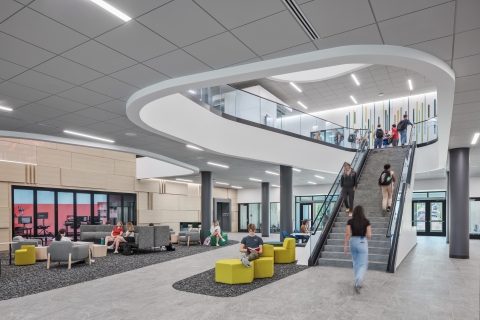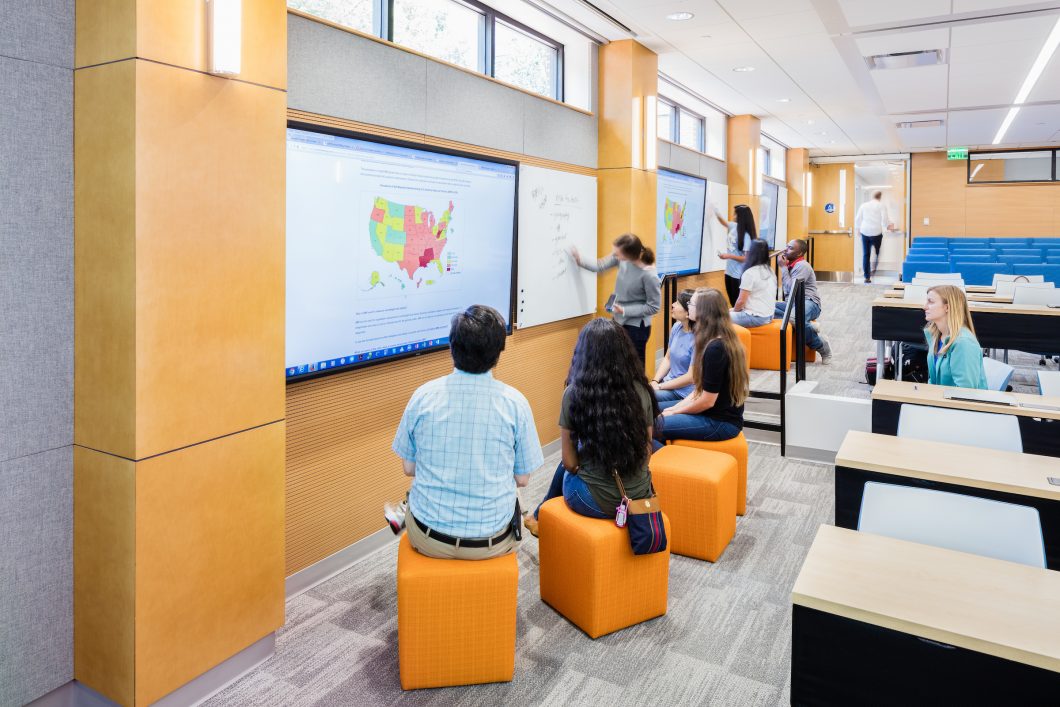
The Role of Physical Space in Corporate Learning and Development

Innovative use of space to create a learning environment that positively affects engagement and retention requires a strategic and coordinated effort backed by senior leadership commitment.
Corporate learning and development (L&D) programs, no matter how compelling, may not be enough in and of themselves as the foundation for developing engaged and productive employees. Historically, the primary focus for L&D was the design of the program, with only minimal thought about spaces where learning takes place. Spaces are viewed as nothing more than places where the program is delivered, be it an off-site training center or a poorly lit, uncomfortable conference room in an underutilized part of a building or corporate campus. Such thinking underestimates the value of creating the best environment for the learning experience.
The ability to truly engage employees through L&D requires a specific type of environment designed to incentivize and ignite the learner. A recent study conducted by Boston Consulting Group found that learning and career development ranked ahead of job security and salary as key priorities influencing happiness on the job. Despite these findings, organizations fail to consider the possibility that a successful L&D strategy requires thinking beyond the training program and considering other influences such as environment and its impact on learning.
A recent series of interviews between BHDP Architecture and leaders in Human Resources, corporate L&D, and corporate real estate (CRE) from more than 50 organizations revealed a disconnect between the physical space and its role in delivery of the L&D experience.
Trends in L&D
“When it comes to L&D, start with understanding culture, your current state, and desired future state,” advises Heidi Scott, Ph.D., HR.com chief learning officer. “Space—physical and virtual—is a huge part of developing the optimal learning eco-system,” she notes, adding that executives should ask themselves if they truly know their people “and where they want to go.”
Corporate L&D is experiencing several trend shifts. One is a change of emphasis from macrolearning to microlearning that provides a more personalized, self-directed, technology-based approach—certainly preferable to endless sessions requiring extensive use of traditional three-ring binders. Perhaps the most interesting of the trends is “gamification”—a term that describes the use of elements such as competition, score keeping, and rewards to encourage learning and engagement. The idea here is to facilitate learning through a shared experience that makes learning fun.
These shifts in L&D are forcing companies to reassess how, and especially where, learning happens. This includes considering whether their existing environment facilitates the desired learning experience and if their employees have the right tools. The latter are readily available in various forms, from massive open online courses (MOOCs) and Google’s G Suite to social media outlets such as Facebook’s Workplace and YouTube, all of which constitute what can be described as a “learning network” spurred by technology. Yet with all this access to digital learning, why should we be so concerned about where learning takes place?
Because space matters.
“Space—physical and virtual—is a huge part of developing the optimal learning eco-system.”
Heidi Scott, Ph.D., HR.com chief learning office
“Space can validate what a company is saying,” notes Felice Rudolph, Asurion Business Services vice president. “We strive to create a life operating system by getting space to empower the employee, validate our brand, and express authenticity to our internal and external stakeholders.”
L&D Supports Corporate Objectives
Today, companies are challenged to enhance the digital learning experience due to the rate of change throughout corporate culture, from technological advancement and shifts in the regulatory climate to desired business outcomes. While it’s important for executives to be aware of shifting L&D strategies, it’s equally imperative for senior leadership to support a culture of learning that can identify and incorporate those elements most beneficial for employee growth and talent retention. L&D has the ability to help organizations break down corporate silos and foster the cross-pollination of ideas throughout an organization. L&D also is charged with the monumental task of reducing the “training to application gap,” which represents the time between training delivery and application of the newly learned skills on the job. The larger the gap, the greater the cost to the organization. Efforts to close it will require effective use of all resources, including CRE’s ability to develop the right environment.
The Case for Space
According to a recent McKinsey Global Institute study, employers will need to manage largescale workforce transformations that could involve redefining business processes and workforce needs, retraining and moving people into new roles, and creating programs for continuous learning.
In recent months, there have been growing investments in the building of corporate learning and development centers by large employers in the Southeastern U.S., including Compass Group and Duke Energy. “L&D is very much impacted by space,” says Maggie Redling, Ed.D., manager of Learning and Development at AvidXchange. “Corporations need to consider the generational aspects of learning. We see that more experienced employees gravitate toward classroom-based learning, while newer employees look for a high-tech, hands-on, discovery-based approach.”
“Providing inspirational space does matter.”
Lisa Gary, chief learning officer at Trane Technologies.
Effective and transformative L&D does not take place in a silo separate from other entities. The most effective L&D experience is one that is woven into the overall real estate strategy, allowing for unlimited access to knowledge and feedback. In addition to L&D and CRE, seek out and welcome input from Human Resources, Information Technology staff, and other key stakeholders. Consider it a structural rethinking of developing and delivering spaces in tune with the demands of the corporation and the needs of its most valuable asset: employees. “Providing inspirational space does matter,” acknowledges Lisa Gary, chief learning officer at Trane Technologies. “We view L&D as a strategic lever enabling business success.”
As experience shows, innovative use of space to create a learning environment that positively affects engagement and retention requires a strategic and coordinated effort backed by senior leadership commitment. When employees feel valued, their motivation soars, as does their performance—both of which can translate into more satisfied customers and increased profits. As companies continually develop approaches to empower employees, it is incumbent upon each of them to constantly evaluate the role of space in a comprehensive learning and development program. CRE deserves a seat at that table.
This article was originally published in Training magazine. Contributors to this article, Dr. Heidi Scott and Lisa Gary, are featured on the Trends + Tensions podcast.
